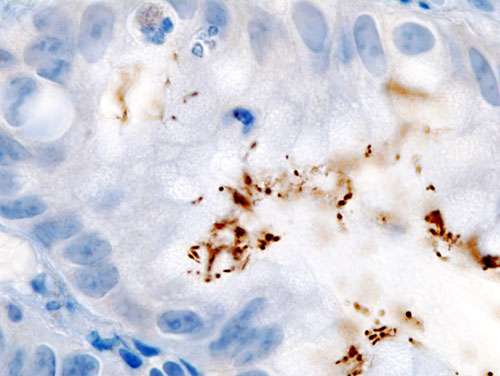Analyzing resistance of Helicobacter pylori infection to antibiotics

Helicobacter pylori (H. pylori) is one of the most common bacterial infections worldwide, affecting more than 40 % of the population and is one of the causes of digestive symptoms, such as epigastric discomfort, heaviness or bloating of the stomach, or of other more serious diseases, such as the development of gastric and duodenal ulcers, gastric lymphoma or gastric cancer. For example, it must be investigated in healthy individuals who have had a parent or sibling diagnosed with gastric cancer, and eliminated.
Antibiotic resistance is the main cause of treatment failure in infectious diseases, and in particular, infection by Helicobacter pylori (H. pylori). In 2017, the World Health Organization (WHO) published a list of pathogens, including H. pylori infection, in which it warned of the need to investigate and promote new therapeutic alternatives due to the public health impact of these bacteria, resulting from antibiotic resistance and the lack of therapeutic options. Bacterial resistance to antibiotics changes over time depending on multiple factors; therefore, it is essential to understand the trend in drug resistance patterns in order to design strategies to reduce the development of resistance and improve treatment regimens.
"Unfortunately," said Luis Bujanda-Fernández de Piérola, Professor of Medicine at the UPV/EHU, "we know that in recent years the efficacy of treatments to combat H. pylori bacteria has been low, often below 80%, despite the combined use of two antibiotics for 7 to 10 days. That is why it is very important to get an overview or snapshot of what is currently happening so as to investigate why this bacterium is resistant to antibiotics."
"This study conducted over the last eight years, in the 2013-2020 period, in Spain and other European countries, such as Italy, France and Norway, aimed to find out and analyze the resistance of this bacterium to the antibiotics that we usually use to treat the infection, and to come up with effective and appropriate treatment," said Luis Bujanda. To do this, "we collected about 4,000 cultures from individuals affected by the bacterium; it is no easy task, since isolating it requires the removal of stomach tissue by biopsy so that it can be analyzed in microbiology laboratories. A gastroscopy is used to extract the sample for the biopsy," explained the UPV/EHU professor.
"Clarithromycin, levofloxacin and metronidazole are the three antibiotics routinely used to treat the infection. However, we have seen that at the same time they are the ones that generate the most resistance. They display resistance of 25%, 20%, and 30% respectively, and these are very high figures," said Luis Bujanda. So, he explained, "It is essential to change the treatment strategies. It is not sufficient to use only two antibiotics to eradicate the infection because the success rate is below 80%; three antibiotics at least need to be used over 10 to 14 days with the possible side effects that may be caused by increased antibiotic use. We are aiming to achieve a success rate of more than 90% in H. pylori infection."
According to Bujanda, "Despite the fact that resistance to the antibiotics we routinely use is high, this study shows that there is a downward trend over time. So, on the one hand, we have bad news, but on the other hand, we have good news because this trend is decreasing." He added that this was probably "because there is an awareness among the population and doctors with respect to better use of antibiotics, given that resistance of this bacterium is very closely linked to antibiotic consumption and misuse ... Resistance, in this case, goes hand in hand with the use of these antibiotics for other infections over the previous 10-15 years."
In the future, "We hope that resistance to these antibiotics will fall below 15% and that we will be able to use fewer antibiotics to eradicate infection with success rates of over 90%, but all this depends on rationalizing the use of antibiotics to prevent resistance from continuing to increase," concludes Bujanda.
More information: Luis Bujanda et al, Antibiotic Resistance Prevalence and Trends in Patients Infected with Helicobacter pylori in the Period 2013–2020: Results of the European Registry on H. pylori Management (Hp-EuReg), Antibiotics (2021). DOI: 10.3390/antibiotics10091058





















